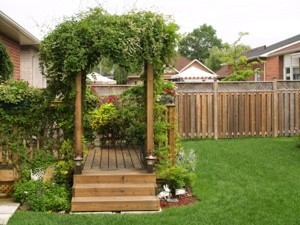
Vines are a great way to add color and interest to your garden. They're great for hiding unsightly views, providing shade, dividing garden spaces, or creating a sense of privacy. Here's how to train them over arbors and pergolas.
Many climbing vines have developed interesting adaptations to scale their way up and over supports. They can be divided into three basic categories--clinging types, grabbing types, and twining types. In general, twining and grabbing vines are the best choices. Clinging vines that use rootlets or adhesive disks can also be used, but they tend to prefer flat, solid surfaces like walls and fences.
Selecting a suitable vine depends on a number of factors including location, soil type, and intended use. To help decide if a certain vine is right for you, ask yourself the following questions:
So which comes first, choosing the vine or choosing the support? It doesn't really matter as long as the vine and support are suited for each other. If you have an existing arbor, pick a vine that can be trained to grow well on arbors. If there is a specific vine you want to grow, make sure you provide it with an adequate support. Some key points to remember:
Vines with coiling leaf and root tendrils need supports made from materials small enough in diameter (usually less than 1") to grab on to. Attaching lattice, netting, or wire coated mesh over arbors and pergolas will allow you to grow more types of vines.
Aggressive climbers and vines producing dense foliage can become heavy very quickly. Make sure you provide these vines with adequate supports for their size and weight.
Some vines grow much taller/longer than others. If you're growing multiple vines on the same support, make sure it's roomy enough and sturdy enough for more than one vine. Likewise, if you're trying to cover an arbor, make sure the vine you select is large enough to cover the structure, or consider using multiple vines.
Arbor and pergolas should be made from materials that are resistant to rot and can withstand the elements. Pressure treated woods like redwood and cedar, or painted metals will last the longest.
Training vines to climb is relatively easy. In the early stages of growth, use fabric ties to tie the main stems to your arbor or pergola. Nylon stockings work great for this because they have a lot of give and allow room for the stems to grow and expand. Before long, clinger-type vines will naturally grab onto the supports on their own, and twining and grabbing types will begin to reach out and wrap their stems and tendrils around supports as they climb. Once the vines catch on naturally, you can remove the fabric ties.
Some vines (e.g. the shrub-like climbing roses) are not natural-born climbers. You'll need to continue to tie the stems of these "vines" to supports as they grow in order to guide their growth in the desired direction.
During early growth, pinch back the terminal stems so the vines "fill out" with foliage before they start getting established vertically. This will help you avoid the common problems of producing sparse growth at the bottom of your structure and a massive growth of congestion on the top.
Once your vine fills out on the bottom, side shoots can be occasionally thinned and removed to encourage continued vertical growth. When the main stems reach the top, you may need to tie them down to the cross beams to guide the vines over the structure. Unless you're going for a naturalized look, expect occasional pruning and tying to control growth and keep your vines from getting "out of bounds." Some flowering vines are pruned immediately after they bloom, while others bloom on last year's growth. Be sure to check the requirements for the vine you select.

About The Author: Ellen Brown is an environmental writer and photographer and the owner of Sustainable Media, an environmental media company that specializes in helping businesses and organizations promote eco-friendly products and services.
Add your voice! Click below to comment. ThriftyFun is powered by your wisdom!
Great tips. I've just started with clematis and find that they have a mind of their own in terms of where they want to climb, but you can gently nudge them in one direction or another. The support is key, though, of large portions will hang down and you won't get the look you want.
This article was great. Thank you. I found it extremely helpful.
Add your voice! Click below to comment. ThriftyFun is powered by your wisdom!